Do you want to display a list of related posts on your WordPress website and prefer to use code rather than a plugin?
At WPBeginner, we often stress the importance of engaging your audience and keeping them exploring your content. One effective strategy we’ve seen used across countless successful WordPress sites is displaying related posts.
When visitors to your blog have finished reading an article they are interested in, offering a list of related posts will keep them engaged and help them find new content to read.
In this article, we will show you how to display related posts with WordPress using code, with no plugin required.
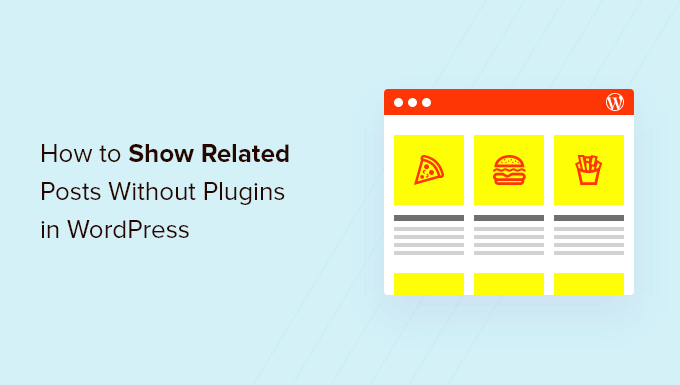
Why Show Related Posts in WordPress?
When your WordPress blog starts to grow, it can become more difficult for users to find other posts on the same topic.
Displaying a list of related content at the end of each blog post is a great way of keeping your visitors on your website and increasing pageviews. It also helps improve the visibility of your most important pages by displaying your best content where people can easily find it.
If you’re not familiar with code, then you will find it simpler to choose one of the many WordPress related post plugins that can display related posts without code.
But, if you’ve ever wondered whether you can display related posts without using a plugin, we’ll share two different algorithms you can use to generate related posts with thumbnails using code alone:
Note: If you wish to show a thumbnail with each related post, then make sure you first add a featured image to those posts.
Method 1: How to Show Related Posts in WordPress by Tags
One efficient way to locate related content is to look for other posts that share the same tags. Tags are often used to focus on the specific details contained in a post.
With that in mind, you may wish to go ahead and add some common tags to the posts you want to relate to each other. You can enter them in the ‘Tags’ box in the WordPress editor.
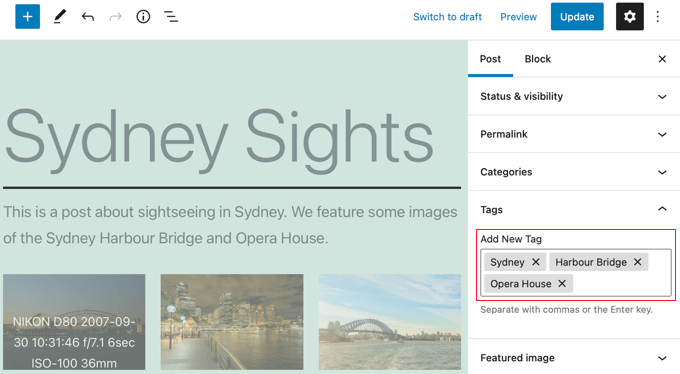
After you have added tags to your posts, the next thing to do is to add the following code snippet to your theme’s single.php template.
If you need help adding code to your site, then refer to our guide on how to paste snippets from the web into WordPress.
$orig_post = $post;
global $post;
$tags = wp_get_post_tags($post->ID);
if ($tags) {
$tag_ids = array();
foreach($tags as $individual_tag) $tag_ids[] = $individual_tag->term_id;
$args=array(
'tag__in' => $tag_ids,
'post__not_in' => array($post->ID),
'posts_per_page'=>5, // Number of related posts that will be shown.
'ignore_sticky_posts'=>1
);
$my_query = new wp_query( $args );
if( $my_query->have_posts() ) {
echo '<div id="relatedposts"><h3>Related Posts</h3><ul>';
while( $my_query->have_posts() ) {
$my_query->the_post(); ?>
<li><div class="relatedthumb"><a href="<?php the_permalink()?>" rel="bookmark" title="<?php the_title(); ?>"><!--?php the_post_thumbnail(); ?--></a></div>
<div class="relatedcontent">
<h3><a href="<?php the_permalink()?>" rel="bookmark" title="<?php the_title(); ?>"><!--?php the_title(); ?--></a></h3>
<!--?php the_time('M j, Y') ?-->
</div>
</li>
<!--?php }
echo '</ul--></ul></div>';
}
}
$post = $orig_post;
wp_reset_query();
This code looks for tags associated with a page and then runs a database query to fetch pages with similar tags.
Where should you place the code? That depends on your theme, but in most cases, you should be able to paste the code into your theme’s single.php template after the main post and right above the comments section.
If you are using the Twenty Twenty-One theme as we are on our demo site, then a good place to paste the code is in the template-parts/content/content-single.php file after the header and just after <?php the_content();.
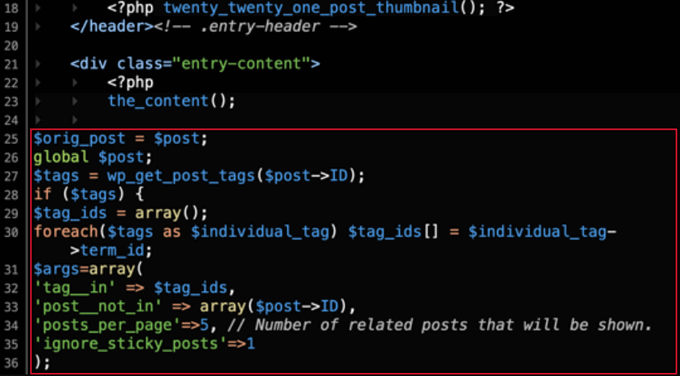
This will automatically display related content on any WordPress post. You’ll need to change the styling and appearance of your related posts to match your theme by adding custom CSS.
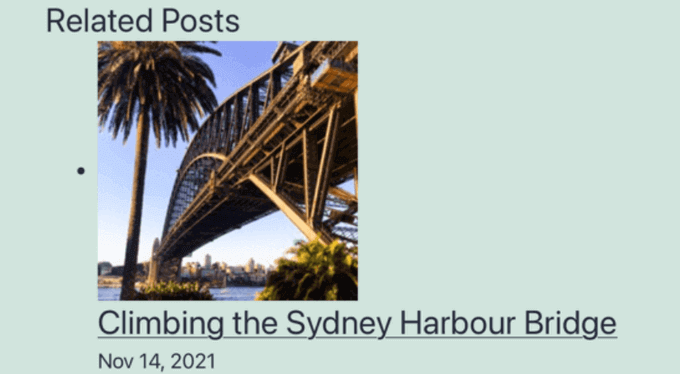
Tip: Instead of editing your theme files, which could break your website, we recommend using a code snippets plugin like WPCode.
WPCode makes it safe and easy to add custom code in WordPress. Plus, it comes with ‘Insertion’ options that let you automatically insert and execute snippets in specific locations on your WordPress site, such as after a post.
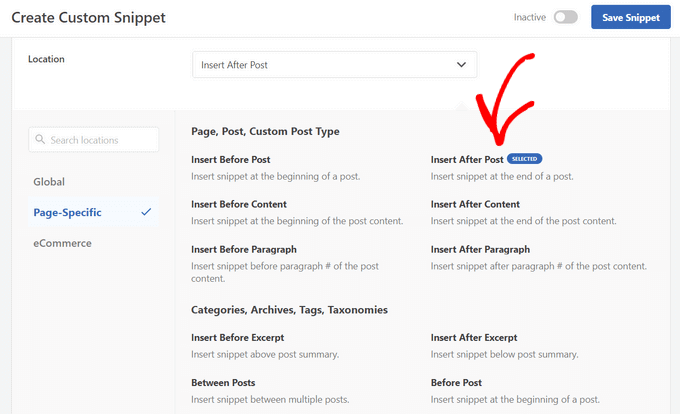
For more details, see our guide on how to add custom code in WordPress. You can also check out our detailed WPCode review to learn more about the plugin.
Method 2: How to Show Related Posts in WordPress by Category
Another way to display related content is to list posts that are in the same category. The advantage of this method is that the list of related posts will almost never be blank.
Like Method 1, you need to add a code snippet to your theme’s single.php template or in a code snippets plugin like WPCode. For more details, refer to Method 1 and our guide on how to add custom code in WordPress.
$orig_post = $post;
global $post;
$categories = get_the_category($post->ID);
if ($categories) {
$category_ids = array();
foreach($categories as $individual_category) $category_ids[] = $individual_category->term_id;
$args=array(
'category__in' => $category_ids,
'post__not_in' => array($post->ID),
'posts_per_page'=> 2, // Number of related posts that will be shown.
'ignore_sticky_posts'=>1
);
$my_query = new wp_query( $args );
if( $my_query->have_posts() ) {
echo '<div id="related_posts"><h3>Related Posts</h3><ul>';
while( $my_query->have_posts() ) {
$my_query->the_post();?>
<li><div class="relatedthumb"><a href="<?php the_permalink()?>" rel="bookmark" title="<?php the_title(); ?>"><!--?php the_post_thumbnail(); ?--></a></div>
<div class="relatedcontent">
<h3><a href="<?php the_permalink()?>" rel="bookmark" title="<?php the_title(); ?>"><!--?php the_title(); ?--></a></h3>
<!--?php the_time('M j, Y') ?-->
</div>
</li>
<!--?php }
echo '</ul--></ul></div>';
}
}
$post = $orig_post;
wp_reset_query();
Now you will see a list of related content at the bottom of each post.
If you want to change the styling and appearance of your related pages, then you will need to add custom CSS to match your theme.
Expert Guides on Related Posts in WordPress
Want to learn more about displaying related posts in WordPress? Check out these helpful tutorials on related posts:
- How to Display Related Posts in WordPress (Step by Step)
- How to Display Related Posts by Same Author in WordPress
- How to Add Inline Related Posts in WordPress Blog Posts
- How to Display Random Posts in WordPress
- How to Show Related Pages in WordPress
We hope this tutorial helped you learn how to display related posts with thumbnails in WordPress without plugins. You may also want to learn how to track visitors to your WordPress site, or check out our list of 24 tips to speed up your website.
If you liked this article, then please subscribe to our YouTube Channel for WordPress video tutorials. You can also find us on Twitter and Facebook.





imranhunzai
Absolutely awesome! and yeah it helps.
8MEDIA
amazing post ,, thanks
shaileshtr
It is good to show related post in wordpress blog without plugiN. iIt will consume less bandwidth and time to load. http://shareitto.com Thanks for your suggestion.
zioneyemedia
I do have a question on this: I’m wrestling on the code to capture posts from child categories versus parent categories. Any advice?
AmandaLong
This rocks … Thanks!
dustinporchia
I’m trying to use the related posts by category and I noticed that you said the code has to come before the comments in the main loop. In my code I want the related posts to come after the comments in the loop. When I do this I notice my disqus comment plugin takes longer to load now. Is that because of an error with the comments or is that normal?
dustinporchia
Nevermind…I just switched to livefyre as this is more of what I’m looking for in a comment system anyways…thanks!
subzerokh
please
could someone help a newbie like me customize this script so it’ll display related post in an horizontal way?
from left to right..
instead of currently showing it from up to down, vertically…
zioneyemedia
Hey,
How I did it is I replaced the and codes with my own html and css. The codes create lists for each post, and that is usually in a vertical fashion.
——————
<a href="” rel=”bookmark” title=””> <a href="” rel=”bookmark” title=””>
——————
I replaced the opening with and replaced the closing with as my html tags. Then I write my CSS to fit that specific div class needs on your website. For example, a sample pleft class could look like this:
.pleft {float:left; padding:2px; margin:10px; width:278px; height:190px;}
I use the float: selector on my CSS to move posts horizontally, and the margins and padding to give each post spacing within each other. I added in a specific width and height for additional examples.
Hope this helps.
Simos
@zioneyemedia thank you!
gcog
I’ve got related tags for sure, but when I add the code I see nothing. Also, when I add your code to restrict to a custom post type, it gives me an error. I did change the post type to my specific post type.
subzerokh
@wpbeginner hello
thanks for your quick answer…
but i’m a real novice at all you are saying..
can you please give a litlle exemple?
for making them horizontal as on your own blog?
can get in touch by my mail: khiloc at gmail dot com
wpbeginner
@subzerokh You would have to edit the styling. It is not that hard. Simply wrap each post in a div. Specify a width for that div and then set a float left property. Adjust the margins and such and you have it.
subzerokh
hello all!! thanks for this wonderfull script!!
It’s the only thing i found doing exactly what i wanted!!!
But it’s just showing related post in vertical way (from up to down)
I would like it to be shown from left to right (horizontally)
How to do that please??
ConnectIndia
Error Fatal error: Call to undefined function the_post_thumbnail() in /home/connec92/public_html/wp-content/themes/weekly/single.php on line 59 Can some one help. website http://www.connectindia.co.in
xavpro
hey,
great post! maybe you could help me:
i have a auto thumb if none is defined,
if ($thumb_array[‘thumb’] == ”) $thumb_array[‘thumb’] = ‘link to your default thumbnail image’;return $thumb_array;
now my question is how to define a thumb for each category, which will be used if none is defined at post.
dehahs
works nicely, thanks for sharing!
AdnanAsif
Hi
thanks for your great post..
But any change to get posts by categories but not in ul and li and not in thumb..
I mean full posts show in related posts..just like show on home page, with readmore link.
thanks
waiting your reply..
AdnanAsif
Hi
thanks for your great post..
But any change to get posts by categories but not in ul and li and not in thumb..
I mean full posts show in related posts..just like show on home page, with readmore link.
thanks
waiting your reply..
ibadullah25
Can I have a CSS For this please
Editorial Staff
The CSS we used was for a client’s site. You can add your own CSS on how you want to display this.
Admin
titusmagnet
Thanks..im searching for this kinda Code
jaffa
This is great, just what I have been looking for. I wonder though, how could I combine the two above and if there are no tags then it displays posts from the same category?
Trying to figure this out but not getting very far yet
nikbanks
Thanks for the code it worked but how do I style it. I’d like it to be 4 stories side by side like yours. It is listed one on top of another on my site and not listed like yours.
Editorial Staff
That is CSS. We are not using this code to show related stories. Second, i believe what you are talking about is featured stories on our sidebar. We have written another post about that in our site.
Admin
Coolguy
is ther a way to dispay the thumbs in related post without using featured images or post thumbs??
i.e to use any image used in the post …
Editorial Staff
Yes, you can utilize the fallback techniques shared by other developers which pulls the first image from the post. But we recommend using the WordPress post thumbnails…
Admin
Hetal
Thanks for this article. I was wondering if there is a way to auto-tag posts without having to manually enter them.
Editorial Staff
No you have to tag each post manually.
Admin
Sisko
Great!
What if I want to display related posts by category without thumbnails?
Thanks
Editorial Staff
Just remove the thumbnail code from the code above
Admin
Terry
Thank you for posting this tutorial, it helps me a lot.
Adrian
Hi there…Just wanted to say that I’ve been building my wordpress website from the ground up and this code works perfectly for me using WP 3.1….All I need to do now is style the CSS and get some thumbnails happening for the posts. Thanks for your help with the code.
new car release
thanks, i’m looking this hack for so long and you got it to me!
Patricia
Hi, is there a way to exclude categories? I have two main categories where all the categories get assigned to. The main categories have sub-categories and I would like to show just related posts from the sub-categories.
Is this possible, by excluding the id’s of the main categories?
Thanks for your advice!
BTW…love the code…and it works great!!!
Editorial Staff
You should be able to use category not in <<
Admin
usman
I was searching for related post with thumbnails plugins but the code that you paste above, solve my problem.
John
Just one question, is there a way to only pull tags from the same post type? Maybe using something like ‘post_type=videos’?
John
By the way, got this figured out as well:
Just add it to the array:
$args=array(
‘category__in’ => $category_ids,
‘post__not_in’ => array($post->ID),
‘posts_per_page’=> 2, // Number of related posts that will be shown.
‘caller_get_posts’=>1,
‘post_type’=>’videos’
);
marion
Hi,
Thank you for this tutorial. I’m wondering though if there’s anyway the related products can be randomized? I’ve checked different products in the same category and the same related products were shown.
Thanks
Editorial Staff
Yes use the Query_Post parameter for order and you can randomize it.
Admin
Clarence Johnson
Good to know.
phdean
Hi,
I too would like to randomize the posts that display for the categories as, otherwise, they’ll display the same 2 every time. Can you please give me the code to do this?
Many thanks in advance
John
Nevermind, I got it figured out. Thanks for the post!
Editorial Staff
what was the issue?
Admin
John
I didn’t have any other posts with the same tags, i.e. no related posts. Dummy mistake.
John
I copied this code and put it in my single.php without changing a thing and nothing gets outputted. Anything wrong with my code? pastebin.com/kg0SkrAg
James
This doesn’t bring up a thumbnail — there isn’t even a call for an image int eh code. I don’t see how anyone can get this to work.
Editorial Staff
The code for the image is: the_post_thumbnail(); << This is not static html where you will see img src code. The function calls in the database to search for a featured image aka thumbnail that is attached to each article. If found, it will output the image. Now if you do not have post thumbnails enabled in your theme, then you need to add it first:
https://www.wpbeginner.com/wp-themes/how-to-add-post-thumbnails-in-wordpress/
The article clearly stated that in the Note: section. You should consider reading it thoroughly.
Admin
Roberto Silva
hey man, I love your blog!
I have a question?
Can you do the same trick but ” BY Author” ?
showing the latest posts by author?
you will save my life
Btw thanks for this website!
Editorial Staff
Yes we will que the article soon
Admin
Roberto Silva
yessss, thanks…
It will be a great article.
bacause “latest posts by author without plugin” is hard to find on internet.
you are the best.
Quinn
Thanks for this code! I’ve given it a try and it works somewhat.
I can get it to give a listing of the related articles, a huge benefit.
But I can’t seem to get any images to show up.
The articles have images if this code scrapes.
I also went in and created images for each post with the custom tag “relatedthumb”. But alas, still no images.
Is there something else I need to do?
Many thanks in advance!
Quinn
Editorial Staff
This trick is using the default WordPress thumbnails which was added in WP 2.9. If you have an image attached as that thumbnail, then it will pull it.
Admin
Anthony
Is it possible to exclude a category from this module ?
Thanks a lot,
Anthony
Editorial Staff
It will only shows post on the category that the other post resides in…
Admin
Madhav Tripathi
Hi, thanks for this good tutorial, currently I am using Thesis theme, so I want to know if there is a way in thesis theme implement this .php code.
Sophie
I’m trying to modify his code in order to use it with categories within a custom post type. Can anyone help? I’m fairly new to php.
Thanks!
rulethenation
ok i got it to work, is there anyway to put a default pic if a thumbnail is unavailable
Editorial Staff
Yes, you can use the if paramter to check if there are plugins… if not then you can display a default image.
Admin
rulethenation
how would i go about doing that? im a php noob lol
Quickbrown
In order to use default images when no post thumbnail available, replace with <?php if (has_post_thumbnail()) {the_post_thumbnail()} else {echo '’;} ?>
Then put a default-image.jpg under your themes’ image folder.
rulethenation
i cant get this to work, it just messes up my whole layout near the comments, am i missing something? i had to take it off my site
Clarence Johnson
My posts are now enriched thanks to you and this tutorial.
Heather Hill
HI!
Thanks for this information! This is exactly what I was looking for.
Is there a way to add an excerpt to this, along with the photo?
Thanks again for your help!
Editorial Staff
Yes. Just add the_excerpt(); where you want it to display excerpt.
Admin
Jez
Thanks for this, exactly what I was looking for! I love how straight to the point your articles are, no confusion.
Omer Greenwald
Thanks for sharing. I’m using this code for a while now but it has a problem: when adding tags to a post, WP sorts them alphabetically regardless of the priority I added them. So this code displays related posts matching the first tag only which are less relevant sometimes.
Maybe you have an idea how to prevent this auto sorting of tags by WordPress or any other solution?
Editorial Staff
It is not using the first tag. This code is using all tags from the posts to find related posts.
Admin
Clarence Johnson
I’m experiencing the same issue too.
Doug C.
All that first code did was put two instances of the same post on the page. It didn’t show any related anything.
Editorial Staff
Doug please contact us using the form with a live link example, and we can help. We know this code is working because a few of our client’s site is using it.
Admin
Noor
Very use article, thanks for updating
Liam
Great tutorial. Would someone mind showing me a working single.php with this code?
I’m still learning php.
Unfortunately
Parse error: syntax error, unexpected T_ENDIF in C:\xampplite\htdocs\mock\wp-content\themes\scwd\single.php on line 76
Editorial Staff
Here is a working example Flowtown Blog.
Note that this code is so it will work inside the loop. Where are you trying to post this? If it is outside the loop then just add the end if code endif; << like that.
Admin
Liam
http://pastebin.com/m60c96f5f
I hope the link works. Thank you.
Editorial Staff
Don’t know what could be going wrong. After the clearfloat class it should work fine. That is how we put it in flowtown and it is working perfectly.
Liam
I will finish the theme and try it on a live site instead of xamp. I will let you know.
Shahab
Nice tutorial!
Right now i am using YARPP but would love to give this a try!
Thanks
Suriya Kumar P
You guys r really doing a great job. thankz a lot.
Vivek @ InfoEduTech
Thanks for this article. i am searching for lot of time to show the thumbnails with my article i am unable to perform this. i have tried many wordpress plugin but couldn’t done this. hope this might help me out